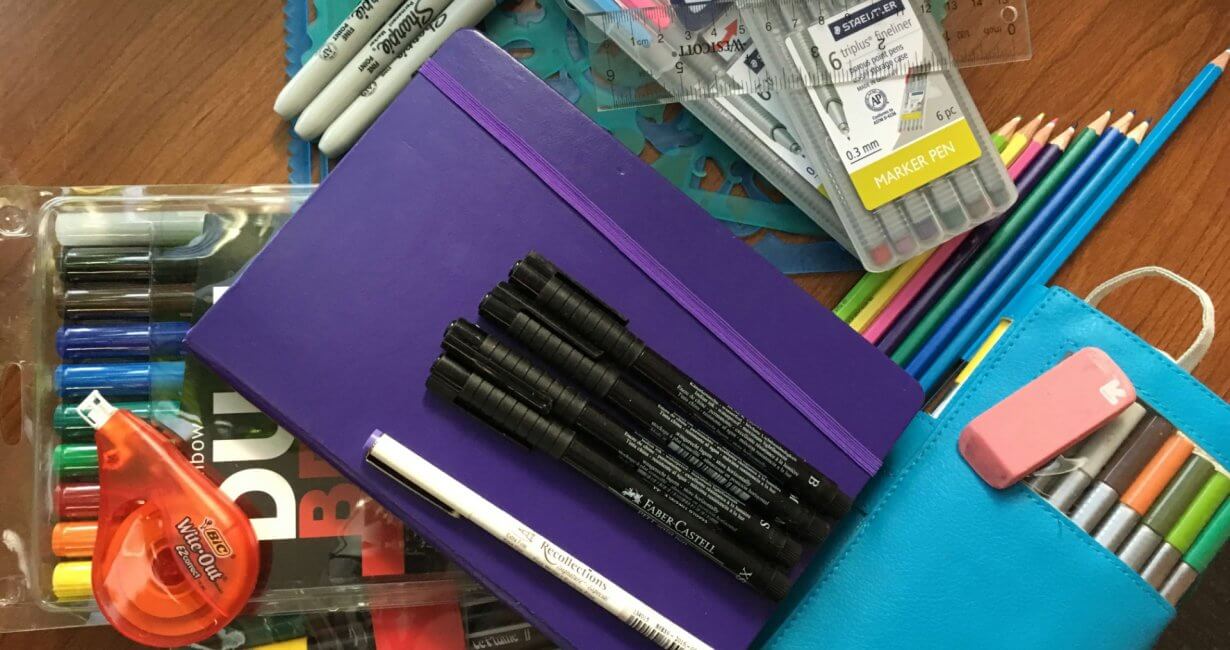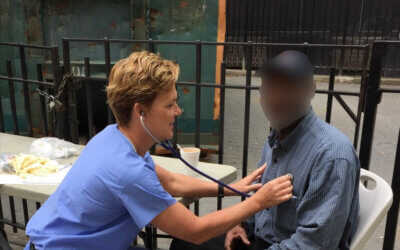How to Start Bullet Journaling for Patients and Caregivers
Bullet journaling for patients and caregivers can assist in more ways than one when it comes to individuals who are facing end-of-life challenges.
 A sample of bullet journal supplies to get you started
A sample of bullet journal supplies to get you started
With schools across the country beginning to open again for fall sessions, many of us are reminded of by-gone days. Cracking the binding on a new notebook was something to look forward to as the new school year kicked off. It was a way to keep track of assignments, take notes and sometimes doodle. Later in life, we graduated to more sophisticated timekeepers such as Day Runner, At-A-Glance, Franklin Day Planner and the like. Some of us might even have jotted down our thoughts and innermost feelings in a true-blue journal. But today, something of a hybrid has evolved. This time management tool—and so much more—can assist in more ways than one when it comes to individuals who are facing end-of-life challenges. So let us introduce you to bullet journaling for patients and caregivers.
What is a Bullet Journal®?
It all started in 2007 in Brooklyn, NY, with digital product designer Ryder Carroll, who had a conversation with a colleague about the methodology she was using in planning her upcoming wedding. Her planning relied on using sticky notes, random envelopes and several notebooks. Ryder knew that this was no way to plan a wedding unless you wanted disaster to strike.
So Ryder showed the bride-to-be his notebook and how he organized his tasks. This was the first time he had ever shared his ideas with anyone: It was an infant bullet journal. Fast forward to August 18, 2013, the date Ryder launched the website bulletjournal.com. (Wishing Ryder and the folks at bulletjournal.com an early happy four-year anniversary!)
A bullet journal is a method to keep track of tasks, take notes and jot down thoughts in one convenient location. The ”bullet” term is derived and used to describe the technique of using quick and short descriptions (“rapid logging”) for all of the above. Picture a short-hand and visual cue to quickly categorize whatever you need to capture in order to keep life on track. And that’s a bullet journal in a nutshell.
Getting Started Bullet Journaling for Patients and Caregivers

Once a decision is made to start the practice, it is fairly easy to begin bullet journaling for patients and caregivers. A bullet journal can be simple and minimalistic or as detailed and elaborate as you want. It is yours to make work best for you and meet your needs. You can use your bullet journal to keep track of:
- Tasks and your to-do list
- Appointments and events
- Medications
- Meals and water intake
- Short-term and long-term goals
- Trips
- Weather
- Thoughts and reflections
- Books, TV shows and movies
- Memorable moments and so much more
When a number of individuals are involved, bullet journaling for patients and caregivers is a wonderful method for everyone to keep track of multiple tasks and appointments. It is also a great way to capture thoughts, feelings and life’s little and big moments.
Bullet Journal Roadmap
Even though each person’s bullet journal is unique to them, they all have common components. These standard practices actually make it a bullet journal.
Index
This is the location where you write down where other pages are located. Simply put, it is similar in theory to an index in the back of a book, which allows you to locate specific pages when you need to find something in particular. Most journals used for bullet journaling are numbered, so it is easy to note sections associated with specific pages.
Key
As stated above, various symbols are used next to items so you can quickly check on the status of tasks, appointments and notes.
- Dot or bullet (●): Task
- X: Task that’s completed
- Open circle (○): An appointment or event
- Dash (─): Note or thought
- Less than symbol or left-pointing arrow (<): Scheduled task
- Greater than symbol or right-pointing arrow (>): Task that wasn’t completed so needs to be postponed to a future day in your bullet journal. This symbol is often used to describe a task that has “migrated.”
- Slash (/): Task that was started and is in progress

Future Log
A future log is the section of a bullet journal where you can record and keep track of birthdays, anniversaries, holidays, trips and goals for the year.
Month Spread
Most people who use bullet journals take two pages to sketch out a month. For the most part, this section is used like a conventional calendar.
Weekly Spread
For some, creating a weekly spread is the next step in setting up a bullet journal. If not, just skip to daily bullet journaling.
Daily Pages
You can use one page for each day, or log several days on one page. It is entirely up to you on how you want to use your bullet journal. If, during one week, you need one page for one day and then decide to switch to multiple days on the next page, great! With a bullet journal, you have the luxury to adapt to make it work for you.
Supplies for Bullet Journaling
If you take a minimalist approach to bullet journaling, you don’t need much beyond a simple notebook and a pen. But if you want to expand your horizon and get creative, the following are some suggestions.
Notebooks: Most bullet journalists used a notebook that features a dotted grid in order to make life easier to draw straight lines. The most popular notebook is the Leuchtturm 1917, which is available in a host of colors. The Leuchtturm has a ready-made index page, ribbons that can be used as page markers, quality paper that isn’t susceptible to color bleeding and a pocket sleeve on the back cover. Other notebook possibilities are Rhodia, Moleskin and Essentials by Peter Pauper Press.
Pens: Like the notebooks, there are different pen choices to suit an individual’s needs. You can opt to use pens with erasable ink, like Pilot Frixion. Another great choice, Faber-Castel Pitt Artist pen, is used by many bullet journalists. This pen is also available in different widths from extra-fine to bold. Then there are Staedler Triplus Fineliners, which come in a variety of colors and even in themed sets. And for those who might become obsessed with bullet journaling and want to treat yourself to a very special pen, you can always check out fountain pens, especially Goulet Pens.
What would happen if you cross a pen with a brush? You would end up with Tom Dual Brush Pens, which also come in different color sets, and an added bonus is that they are blendable.
Colored Pencils: Think you’d like to add a splash of color to your pages but don’t want to use a pen? Then go with colored pencils like Staedtler Noris Colouring Pencils.
Washi Tape: This bullet journal supply comes in different colors, patterns and can even feature words. Washi tape can be used for decoration but can also cover mistakes or mishaps. Speaking of making mistakes in your bullet journal, if this is a concern, just keep wite-out tape on hand, and you’ll be all set.
Stencils: Using stencils can easily make your journal look consistent and professional. You can also get quite creative with stencils. They can be found at the large craft stores. But if you want to support an independent artisan, go to Etsy and type “bullet journal stencil” into the search, and just wait to see how many options you’ll have with just the click of a button.
Pre-printed spreads: Many of the long-standing and established bullet journalists make pre-printed spreads available for members. The spreads are either free or can be purchased for a nominal fee.
Chapters Health System is committed to serving the needs of its patients, families, caregivers, health providers, partners and communities.
Discover more details and information about caregivers.
For more information, please call our helpful Chapters Health and HospiceHelp24® team at 1.866.204.8611 or Contact Us.
Keep Exploring
















